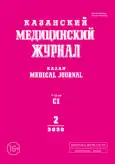Percutaneous puncture nephrostomy on the back of a patient with an external fixation apparatus on the bones of the pelvis following a road traffic accident
- Authors: Abdurakhmanov RA1
-
Affiliations:
- Municipal Hospital №5
- Issue: Vol 101, No 2 (2020)
- Pages: 275-278
- Section: Clinical observations
- URL: https://journal-vniispk.ru/kazanmedj/article/view/20706
- DOI: https://doi.org/10.17816/KMJ2020-275
- ID: 20706
Cite item
Full Text
Abstract
The article presents a rare clinical case of renal colic with a stone in the lower third of the ureter in the patient after a traffic accident with an external fixation device on the pelvic bones. A 41-year-old patient was hospitalized to the emergency urology department of the City Hospital No. 5 of Naberezhnye Chelny in 2019 with renal colic on the right. An ultrasound revealed right pelvocaliectasis of kidney. Pelvic survey (urogram) shows the shadow (9 mm in diameter) suspicious for renal calculus in the projection of the lower third of the right ureter. The pain was not relieved by analgesics. It was unsuccessfully attempted to stent the right ureter due to insurmountable obstacle at a distance of 4 cm from the ureteral orifice. Due to technical complexity (laying the patient in a lithotomy position and on the stomach or side was impossible due to a possible breakdown of the external fixation apparatus on the pelvic bones) percutaneous puncture nephrostomy was performed under ultrasound control in the supine position according to emergency indications. The pain was relieved. The patient was discharged home. After one month, the external fixation device for the pelvic bones was removed. The patient was hospitalized again. Ureteroscopy and contact ureterolithotripsy on the right ureter were performed routinely. Nephrostomy was removed. The patient recovered. The described case is of clinical interest as a rare combination of renal colic and the presence of an external fixation apparatus on the bones of the pelvis, which causes additional difficulties for the drainage of the urinary tract. Percutaneous puncture nephrostomy on the back with a roller in the ipsilateral kidney is a good alternative for urologists when to lay the patient on the stomach or side is impossible.
Full Text
##article.viewOnOriginalSite##About the authors
R A Abdurakhmanov
Municipal Hospital №5
Author for correspondence.
Email: rustam.abdurakhmanoff@yandex.ru
SPIN-code: 3533-3741
Russian Federation, Naberezhnye Chelny, Russia
References
- Martov A.G., Andronov A.S., Ergakov D.V., Duto S.V. Percutaneous nephrolithotripsyon the back. Saratovskiy nauchno-meditsinskiy zhurnal. 2011; 7 (S2): 52–56. (In Russ.)
- Yanitskaya M.Yu., Proklova L.V., Kyrkalova T.I. et al. Percutaneous puncture nephrostomy under the control of ultrasound in children. Saratovskiy nauchno-meditsinskiy zhurnal. 2007; 3 (2): 81. (In Russ.)
- Vozianov S.A., Ladnyuk R.V., Mazurets V.A., Valerko D.A. Percutaneous nephrostomy in the complex of curative measures for patients with complicated ureterolitiasis. Meditsinskie novosti. 2013; (5): 76–78. (In Russ.)
- Konyushkin A.E. Postoperative bile peritonitis after percutaneous nephrolithotomy: case analysis and treatment strategy. Vestnik urologii. 2019; (2): 112–116. (In Russ.) doi: 10.21886/2308-6424-2019-7-2-112-116.
- Vozianov S.A., Gorzov A.A., Kravchenko N.I. et al. Percutaneous puncture nephrostomy — method of choice in the treatment of patients with full obstruction in upper urinary tracts and renal failure. Pochki. 2013; (4): 7–10. (In Russ.)
- Demin D.A. Percutaneous puncture nephrostomy in the treatment of complications of urolithiasis. Byulleten' medicinskih internet-konferencij. 2015; 5 (5): 424. (In Russ.)
- Martov A.G., Dzhafarzade M.F., Dutov S.V. Features of percutaneous puncture nephrolithotripsy in patients with horseshoe kidney. Vestnik Rossijskogo nauchnogo centra rentgenoradiologii Minzdrava Rossii. 2012; (12-1): 19. (In Russ.)
- Trapeznikova M.F., Dutov V.V., Urenkov S.B. et al. Percutaneous nephrolithotripsyi nelderly patients. Saratovskiy nauchno-meditsinskiy zhurnal. 2011; 7 (S2): S253–S256. (In Russ.)
- Amon Sesmero J.H., Del Valle Gonzalez N., Conde Redondo С. et al. Comparison between Valdivia position and prone position in percutaneous nephrolithotomy. Actas. Urol. Esp. 2008; (32): 424–429. doi: 10.4321/S0210-48062008000400007.
- De Sio M., Autorino R., Quarto G. et al. Modified supine versus prone position in percutaneous nephrolithotomy for renal stones treatable with a single percutaneous access: a prospective randomized trial. Eur. Urol. 2008; (54): 196–202. doi: 10.1016/j.eururo.2008.01.067.
- Egilmez H., Oztoprak I., Atalar M. et al. The place of computed tomography as a guidance modality in percutaneous nephrostomy: Analysis of a 10-year single-center experience. Acta. Radiol. 2007; 48: 806–813. doi: 10.1080/02841850701416528.
- Kim S.C., Lingeman J.E. Percutaneous access to the urinary tract. In: Nakada S.Y., Pearle M.S. eds. Advanced endourology. The complete clinical guide. Totowa, NJ: Humana Press. 2006; 43–60.
- LeMaitre L., Mestdagh P., Marecaux-Delomez J. et al. Percutaneous nephrostomy: Placement under laser guidance and realtime CT fluoroscopy. Eur. Radiol. 2000; 10: 892–895. doi: 10.1007/s003300051030.
Supplementary files








